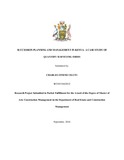| dc.description.abstract | Majority of Quantity Surveying (QS) firms in Kenya are faced with the possibility of winding up with their founders exit while other firms have turned into vocational practices with the founders facing their sunset days with no hopes of retiring. Concurrently, there is growing chorus on the need for older professionals to develop, groom and integrate the younger professionals into more responsibilities to progressively take over the QS practices to ensure continuity. Current dynamics in the construction industry also demand that firms attract, retain and internally develop potential partners/talent as key to the firm’s future success. Yet, notwithstanding the call for generational transfer of leadership and the market dynamics, Succession Planning and Management has largely remained on the back burners.
This research sought to investigate how succession occurred in QS firms, the benefits and the challenges of succession planning and management (SP&M). The study employed a qualitative research methodology based on grounded theory approach. This was necessary to describe and understand the succession phenomena as understood and practised by Kenyan QS firms. Data was collected via questionnaires administered to 30 firms.
The findings indicate that succession in majority of QS firms is largely unsystematic, informal and accidental as only 32% of firms had systematic SP&M programs. There was a weak correlation between the ages of firms, number of directors and adoption of SP&M although private limited companies were most likely (75 percent) to have a systematic succession plan than partnerships. The firms with SP&M were driven by the realization of difficulties in talent/HiPos attraction and retention in an increasingly competitive labour market and the need to have the bench strength as they strategize on future expansion. The firms enjoyed several benefits, among them: continuity and sustained business, consistency in output and operations, improved employee morale and retention and expansion of firms’ directorship. The challenges to SP&M efforts were mostly lack of coordinated follow-through on employee developmental programs, difficulty in identifying true successors and HiPos, insincere discussion, founder’s syndrome, nepotism, mistrust, impatience of younger professionals and lack of capacity by HiPos to buy into firms. The implications of these findings point to the need for sensitization of QS firms on systematic SP&M programs and how to avoid common pitfalls in the succession planning and management effort. | en_US |



